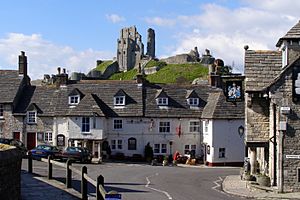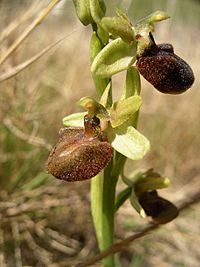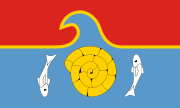Isle of Purbeck facts for kids
The Isle of Purbeck is a special area in Dorset, England. It's not really an island, but a peninsula! This means it's surrounded by water on three sides. To the south and east, you'll find the English Channel with amazing steep cliffs. To the north, there are marshy lands from the River Frome and Poole Harbour.
The western edge of Purbeck is a bit harder to define. Some old maps show it near Flower's Barrow and Worbarrow Bay. A writer named Ralph Wightman once said Purbeck feels like an island because the wild, open lands between Arish Mell and Wareham cut it off, just like the sea does. The very tip of Purbeck to the south is called St Alban's Head.
From 1974 to 2019, the whole Isle of Purbeck was part of a local government area called Purbeck. This area was named after the peninsula. Now, since April 2019, the Isle is part of the larger Dorset council area.
The southern part of the Isle of Purbeck, including its coast, is a special natural area. It's called National Character Area 136 - South Purbeck. To the north are the Dorset Heaths, and to the west are the Weymouth Lowlands.
Contents
Amazing Geology of Purbeck
The rocks and landforms of the Isle of Purbeck are very interesting! The northern part has Eocene clay, which includes important deposits of something called Purbeck Ball Clay.
As you move towards the sea, you'll find layers of Jurassic rocks. These include famous stones like Portland limestone and Purbeck beds. The Purbeck beds contain Purbeck Marble. This "marble" is actually a very hard limestone that can be polished beautifully. Many old cathedrals in England used this stone.
A long ridge of Cretaceous chalk runs across the peninsula. This forms the Purbeck Hills. These hills are part of a huge chalk formation that stretches across Southern England, including places like Salisbury Plain and the Isle of Wight.
The cliffs along the coast are truly spectacular. They are important for geologists because of the different rock types and amazing landforms. Two famous examples are Lulworth Cove and Durdle Door. This coastline is so special that it's part of the Jurassic Coast World Heritage Site!
Quarrying and Mining History
In the past, people dug out a lot of limestone from Purbeck. This was especially common around Swanage, and in villages like Worth Matravers and Langton Matravers. You can still see old quarries along the cliffs, like the "caves" at Tilly Whim, Dancing Ledge, Seacombe, and Winspit.
Workers would move the stone from these cliff quarries either by sea or using horse carts. Much of London was rebuilt with Portland and Purbeck stone after the Great Fire of London.
Ball clay was also very important. It was mainly dug up between Corfe Castle and Wareham. At first, horses carried the clay to docks on the River Frome and Poole Harbour. Later, horse-drawn tramways were used. When the railway came to Swanage, most of the ball clay was sent by train to places like Staffordshire, where pottery is made.
Today, quarrying still happens on Purbeck. Both ball clay and limestone are transported by road. However, there are no longer any working quarries for Purbeck Marble. If you want to learn more, the Purbeck Mineral and Mining Museum has exhibits about ball clays, mining, and the old narrow-gauge railways.
Wonderful Wildflowers of Purbeck
The Isle of Purbeck has more types of native and old wild flowers than almost any other area of its size in Britain! This is because of its varied geology, which creates many different habitats.
One of the most sought-after flowers is the Early Spider Orchid (Ophrys sphegodes). In Britain, it's most common right here on Purbeck. In 2009, nearly 50,000 flowering stems were counted! The best time to see them is in late April. The largest group is usually in the field west of Dancing Ledge. You can also find smaller numbers in Durlston Country Park. This beautiful orchid is even the logo for the Dorset Wildlife Trust.
Soon after, in early May, you can see meadows full of yellow Cowslips (Primula veris). Durlston Country Park has several large meadows of these.
Many woods on Purbeck have carpets of Wild Garlic (Allium ursinum) in early May. King's Wood and Studland Wood, both owned by the National Trust, are great places to see this. Around the same time, some of the Downs are covered in yellow Horseshoe Vetch (Hippocrepis comosa) and blue Chalk Milkwort (Polygala calcarea). In late May, the field near Old Harry Rocks turns yellow with Kidney Vetch (Anthyllis vulneraria).
In June, blue and white Sheep's bit (Jasione montana) and pink Sea Bindweed (Calystegia soldanella) add color to the Studland dunes. Both Heath Spotted Orchid (Dactylorhiza maculata) and Southern Marsh Orchid (Dactylorhiza praetermissa) are common on Corfe Common that month. Harebells (Campanula rotundifolia) and Purple Betony (Stachys officinalis) also add color to the Common in July.
Dorset Heath (Erica ciliaris) is the official flower of Dorset. You can find large numbers of it in July and August, especially on and around Hartland Moor. It grows in the damper parts of the heathland. Bog Asphodel (Narthecium ossifragum) shows off its yellow flowers there in early July. Marsh Gentian (Gentiana pneumonanthe) is less common but can be found in similar areas from mid-August to mid-September.
A Glimpse into Purbeck's Past
Many ancient Roman-British sites have been found and studied on the Isle of Purbeck. One example is a large Roman villa at Bucknowle Farm near Corfe Castle. People dug here between 1976 and 1991 to learn about its history. The Kimmeridge shale found on the isle was used a lot during the Roman period. People made jewelry, decorative panels, and even furniture from it.
At the very southern tip of Purbeck is St Aldhelm's Chapel. This chapel was built in the Norman style, but it stands on an even older Christian site. This older site is marked by a circular earthwork and some graves. In 1957, the body of a woman from the 1200s was found buried near the chapel. This suggests there might have been a small religious retreat there. In 2000, the entire chapel site was declared a Scheduled Ancient Monument, meaning it's protected for its historical importance.
People aren't entirely sure what the chapel was used for. Some think it was a place for religious retreat, or a chapel to pray for sailors who drowned off St Aldhelm's Head. Others even suggest it might have been a lighthouse or a warning bell for ships! During Victorian restoration work on the chapel, signs were found that a beacon (a warning light) might have been on the roof. The cross you see on the roof today was added during the Victorian era.
The town of Wareham still has its old Saxon earth embankment wall. Its churches also have Saxon origins. One church, St Martins-on-the-Walls, was built in 1030. Today, you can still see traces of medieval and later wall paintings inside.
The Story of Corfe Castle
Corfe Castle is a famous landmark in the center of the isle. It stands proudly overlooking Corfe Castle village. The castle guards a strategic gap in the Purbeck Ridge. The current stone castle was built after the Norman Conquest in 1066. However, it might have replaced an older Saxon structure. This is because the village was where the Saxon King Edward the Martyr was murdered in 978. The place where he was supposedly murdered is traditionally on or near the castle mound.
Corfe was one of the first English castles to be built from stone. At that time, most castles were made of earth and timber. This was probably because there was plenty of good building stone available on Purbeck.
Sir John Bankes bought the castle in 1635. He owned it during the English Civil War. His wife, Lady Mary Bankes, bravely led the defense of the castle when it was attacked twice by Parliamentarian forces. The first attack in 1643 was not successful. But by 1645, Corfe was one of the last places still held by the Royalists in Southern England. It fell after another attack. In March of that year, Corfe Castle was "slighted" (meaning it was deliberately destroyed) on Parliament's orders.
Today, Corfe Castle is owned by the National Trust and is open to the public. It is protected as a Grade I listed building and a Scheduled Ancient Monument.
Exploring the Isle of Purbeck
A large part of the Isle of Purbeck is now a protected area called an Area of Outstanding Natural Beauty (AONB). However, some parts of the coast, like Worbarrow Bay and the ghost village of Tyneham, are still used by the Ministry of Defence as a training area. They have been using it for nearly 60 years!
The Lulworth Ranges are part of the Armoured Fighting Vehicles Gunnery School at Lulworth Camp. Tanks and other armoured vehicles are used here, and shells are fired. For safety reasons, you can only enter these areas when the army ranges are not in use. Large red flags are flown, and flashing warning lights on Bindon Hill and St Alban's Head are lit when the ranges are active. When this happens, the gates are locked, and wardens patrol the area.
Here are some other interesting places to visit on the Isle of Purbeck:
- Swanage: This is a popular seaside resort at the eastern end of the peninsula. It used to have a railway line from Wareham. This line closed in 1972, but parts of it have now reopened as the Swanage Railway, a fun heritage railway.
- Studland: This seaside village has a beautiful sandy bay. Nearby, off the coast from The Foreland, are the famous chalk stacks called Old Harry Rocks. They are known as Old Harry and his Wife.
- Poole Harbour: This harbor is a great spot for bird watchers, windsurfers, and yachters. It's also home to Brownsea Island, where the first-ever Scout camp took place!
- Corfe Castle: This historic castle is right in the middle of the isle, looking over Corfe Castle village.
- Langton Matravers: This village was once home to several boys' preparatory schools. The last one, The Old Malthouse School, closed in 2007.
- Kimmeridge Bay: Here you'll find cliffs rich in Jurassic fossils. It's also the site of the oldest continuously working oil well in the world!
- Worth Matravers: This village is famous for its stone houses built around a pond. It's often featured on postcards of the Isle of Purbeck.
See also
 In Spanish: Isla de Purbeck para niños
In Spanish: Isla de Purbeck para niños





